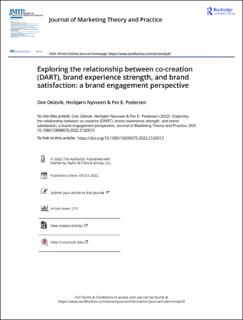| dc.contributor.author | Oklevik, Ove | |
| dc.contributor.author | Nysveen, Herbjørn | |
| dc.contributor.author | Pedersen, Per Egil | |
| dc.date.accessioned | 2022-11-07T14:17:59Z | |
| dc.date.available | 2022-11-07T14:17:59Z | |
| dc.date.created | 2022-10-11T10:53:26Z | |
| dc.date.issued | 2022 | |
| dc.identifier.citation | Oklevik, O., Nysveen, H. & Pedersen, P. E. (2022). Exploring the relationship between co-creation (DART), brand experience strength, and brand satisfaction: a brand engagement perspective. Journal of Marketing Theory and Practice, 1-24. | en_US |
| dc.identifier.issn | 1069-6679 | |
| dc.identifier.uri | https://hdl.handle.net/11250/3030503 | |
| dc.description.abstract | Although a few studies have examined the influences of the co-creation elements of dialogue, access, risk assessment, and transparency (DART), little is known about the mechanisms underlying these influences. In this article, we empirically study the DART element’s influences on brand experience strength and brand satisfaction, and we explore how brand experience strength mediates the DART elements’ influences on brand satisfaction. We use a brand engagement perspective to explain how the co-creation elements influence brand experience strength. A survey (n = 594) of brands from the banking, mobile, hotel, and restaurant services is reported. We find direct influences from all four co-creation elements on brand experience strength, and we find that brand experience strength partly mediates the influences of risk assessment and transparency on brand satisfaction. The results are compared across utilitarian (bank and mobile) and hedonic (hotel and restaurant) services. | en_US |
| dc.language.iso | eng | en_US |
| dc.publisher | Taylor & Francis | en_US |
| dc.rights | Navngivelse 4.0 Internasjonal | * |
| dc.rights.uri | http://creativecommons.org/licenses/by/4.0/deed.no | * |
| dc.title | Exploring the relationship between co-creation (DART), brand experience strength, and brand satisfaction: a brand engagement perspective | en_US |
| dc.type | Peer reviewed | en_US |
| dc.type | Journal article | en_US |
| dc.description.version | publishedVersion | en_US |
| dc.rights.holder | © 2022 The Author(s) | en_US |
| dc.source.journal | Journal of Marketing Theory and Practice | en_US |
| dc.identifier.doi | 10.1080/10696679.2022.2120013 | |
| dc.identifier.cristin | 2060371 | |
| cristin.ispublished | true | |
| cristin.fulltext | original | |
| cristin.qualitycode | 1 | |

